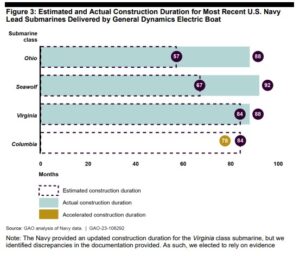A recent Government Accountability Office (GAO) report that audited the Navy’s new Columbia-class ballistic missile submarine (SSBN) argued the program needs an updated schedule risk analysis to assess the feasibility of the current schedule and identify critical risks.
The report was skeptical of the Navy’s plans to achieve delivery of the first nuclear weapons-armed
Columbia-class SSBN within 78 months, six months faster than the original latest date of 84 months from the start of formal construction.
GAO said this is “less time than was planned for the lead Virginia-class submarine–a submarine that is two-and-a-half times smaller and has fewer estimated construction labor hours than the Columbia class.”

The Columbia-class is being built by prime contractor General Dynamics’ Electric Boat [GD] (EB) with main subcontractor HII Newport News Shipbuilding [HII].
EB and the Navy marked the ceremonial start of construction of the first boat, the future USS District of Columbia (SSBN-826), in June (Defense Daily, June 6, 2022).
Electric Boat plans to deliver SSBN-826 in April 2027 versus October 2027 via several methods. GAO said the shipbuilders plans to complete construction of most of the super modules in less time than under the previous schedule, reduce the time between when the hull is watertight and delivered, and complete “key contract and government equipment deliveries earlier than planned.”
The Navy counts this planned six months earlier delivery as additional margin to ultimately ensure on-time delivery within the 84-month time frame.
The report said that the previous lead submarine vessels have had actual construction durations last significantly longer than Navy estimates: the USS Ohio (SSBN-726/SSGN-726) took 88 months rather than the projected 57 months, the USS Seawolf (SSN-21) took 92 months to complete rather than projected 67 months, and the USS Virginia (SSN-774) took 88 months rather than estimated 84 months to complete construction.
GAO noted the Navy received unique statutory authorities from Congress allowing the Navy to complete about seven percent of construction on the lead vessel before congressional authorization to start formal construction, which is not included in the construction duration count.
GAO argued the Navy and DoD lack “essential schedule insight” because the Electric Boat did not conduct a schedule risk analysis of the lead submarine’s construction schedule or provide schedule data in a format the Navy can easily use to validate the schedule’s quality.
“Both GAO-identified leading practices and DoD guidance identify schedule risk analysis as a critical tool for understanding program risks and managing risks that could impact the schedule,” the report said.
It also noted a schedule risk analysis can predict the probability a program can achieve its completion or delivery on time.
The report said DoD guidance for using an integrated master schedule says this analysis “allows programs to more fully account for the potential impact of risks—should they be realized during program execution—and better prioritize which risks they should mitigate.”
The analysis can also help identify and manage high-priority risks and determine if there is enough margin in the schedule.

“By statistically analyzing the effects of potential program changes, schedule risk analysis is critical to successfully meeting program commitments,” GAO said.
GAO noted the Columbia-class is a schedule-driven program and the Navy, shipbuilders, and GAO have all identified “significant program risks” for years.
Over the past year, Navy officials have admitted SSBN-826 has not kept up the pace to be completed at 78 months rather than 84 months.
In November, Adm. Scott Pappano, Program Executive Officer for Strategic Submarines, said the first submarine is now down to only one more month of margin left compared to the planned six months (Defense Daily, Nov. 1).
While much of the margin lost was due to earlier welding mistakes made by BWX Technologies [BWXT] to a dozen common missile tubes, he said EB and HII also had startup issues with new digital work instructions. Pappano said the companies have worked past that and recent months had significant improvements.
The report noted the delays caused “lagging shipbuilder performance on design products, in particular, work instructions,” that persisted at least through February 2022
GAO said the shipbuilders were behind on producing work instructions through February 2022
EB has worked to mitigate increasing schedule delays by shifting staff planned for the Virginia-class submarine to the Columbia-class given its importance to the Navy.
GAO warned this will likely lead to additional delays in the Virginia-class submarine.
The report also argued the Navy needs more long-term planning because the latest 30-year shipbuilding plan looks to building two Virginia-class boats per year and one Columbia-class boat per year, despite the interconnected construction issues.
“However, shared risks between the programs are likely to continue to have a more pronounced impact on the Virginia class program because the Columbia class program is the Navy’s top priority. The shipbuilders and Navy have not yet updated long-term planning documents to reflect how shared program risks could affect submarine production goals for either program.”
GAO said while the Columbia-class program is given some protections from the consequences of delays via priority access to resources as the Navy’s top acquisition priority, “additional information about the costs to mitigate the likely outcome of shared risks would provide the Navy with greater certainty that it requested appropriate resources to meet plans and would enable better long-term planning for future naval forces.”
The report said program officials currently manage schedule risk via the margin and not probabilities, like in a schedule risk analysis.
Therefore, planners insert buffer periods ahead of contractual events and milestones to deal with unforeseen problems. EB told GAO the margin length is often based on internal best practices and lessons learned from the Virginia-class submarine. EB also argued the Columbia-class program is too complex for the traditional simulation-based schedule risk analysis and that would not correctly assess risks to achieving the delivery date.
“However, a schedule risk analysis could enhance how the shipbuilders apply this professional judgment by quantifying the overall amount of schedule margin needed to achieve completion and whether that margin sufficiently accounts for critical risks,” GAO said.
GAO argued other government programs of similar or greater duration, cost and complexity, like the NASA James Webb Space Telescope project, routinely use schedule risk analysis.

“Among other things, this joint assessment evaluates the likelihood that a project plan, reflected in the integrated master schedule, is achievable within the planned date constraints.”
GAO also said the Navy did not require Electric Boat to provide schedule data in their native format, limiting the Navy’s ability to easily validate the quality of the schedule. DoD guidance says programs should assess schedule quality by checking its assumptions and ensuring it has no errors that could affect the schedule analysis.
Navy officials told GAO data in PDF and Excel forms was sufficient for oversight and in the last 30 years the Navy has not required submarine builders to submit native file schedule data.
However, GAO noted surface ship programs receive such data in its native format and “the last three lead submarines of a new class constructed by Electric Boat were delivered an average of 20 months late.”
GAO recommended the Secretary of Defense ensure the Office of the Under Secretary of Defense for Research and Engineering (OUSD(R&E)) conducts a schedule risk analysis of SSBN-826 construction schedule and share results with the program office.
It also recommended the Navy Secretary make sure the program office uses that schedule risk analysis to update plans for vessel delivery and mitigate identified risks, obtain lead and follow-on Columbia-class schedule information from the shipbuilder’s native file format, ensure the program determine an approach to conduct schedule risk analysis for follow-on boats, obtain updated information about the shipbuilder’s Integrated Enterprise Plan that reflects updated execution plans and resources to address shared risks, and ensure the fiscal year 2024 30-year shipbuilding plan is informed by this updated planning and resources to address shared risks between the submarine programs.
DoD concurred with four of the recommendations and partially concurred with the two others.
GAO argued several of the actions DoD described “will not fully address the issues that we discuss in this report.”